|
| |

|
| |
| Introduction: Joe McNally is an expert at
lighting big jobs with small flashes. Besides being a successful
commercial photographer, he also spends a great deal of time teaching.
His new book is titled
The Hot Shoe Diaries and is a virtual how to for setting
up complex lighting using Nikon SB flashes. |
| Normally when we do interviews like this,
we also discuss in detail how some of the photographer's classic images
were taken. But Joe McNally's last two books,
The Moment It Clicks and
The Hot Shoe Diaries go into much more detail about the images
than we would have room to discuss here. LB |
| Chris/Larry: Many consider you to be
one of the best photographers working today. Can you give us some
background on how you started, what influenced you in your development as
a photographer? |
| Joe: I started off as a newspaper wire
service photographer, which is a great teaching ground for making you
improvisational. It enables you to think on your feet, rescuing pictures
when things are really going south and it teaches you a lot about the kind
of survival skills you need in the long run to stay the course in the
business.
I had the benefit of coming along at a time when the field was really
wide-open. Though there are many opportunities that you have now as a
photographer, there was a less pressure when I first started. I hit New
York and came under the tutelage and guidance of a lot of really good
established shooters and editors. It was a kind of atmosphere that if you
made a mistake, it wasn't a disaster, it was a learning experience, you
got back in the saddle the next day and you went out and you shot again.
Because of time, budgets, and other factors, some of that grace period
that you have to grow as a professional is truncated and more pressurized.
I did have a lot of ups and downs and disasters, the typical sort of stuff
that you would have when you start a career in New York. |
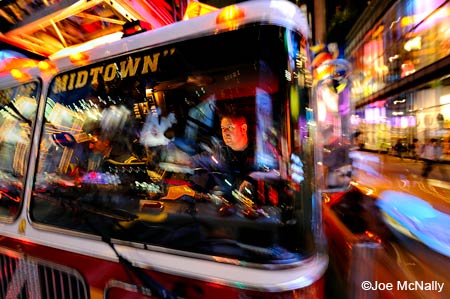 |
| Chris/Larry: You shoot a really wide
range of subjects and have used some pretty creative lighting to define
them. Can you give us an idea for how you approach your subject? How much
do you plan, how much is spontaneous? |
| Joe: It's always a mix. I do rely on
my well-developed sense of curiosity, researching my subject before hand
so I kind of know what I'm getting into. Then I imagine what the job would
be like and I imagine the picture. If I end up with a picture that was
close to what I imagined it would be, I would consider it a pretty good
day. |
| Chris/Larry: Do your images sometimes
go beyond your wildest expectations? |
| Joe: Sure, that happens. Serendipity
can, and does kick in on a regular basis. In terms of serendipity being so
extended or grand as to provide something that you couldn't have dreamed
up in your wildest dreams, that doesn't happen too often. The reverse
happens much more often, where you walk into a situation, you're keyed up
on a job, and you're thinking, oh, maybe I'll do this or maybe I'll do
that. Then, in the very first ten minutes you're on the job you realize
none of that stuff is going to happen. The subject is not cooperating, the
weather stinks, the location is bad, there's a limited amount of time, or
whatever might have happened to affect the outcome.
I was doing a portfolio for Sports Illustrated a couple years ago, and
I ended up having to shoot a picture in three parts and have the magazine
put it together back at the shop because I missed my connection in Salt
Lake City. It's the practical aspect of being a photographer. I couldnít
get to the location early enough because I missed my flight because of a
plane delay, and that put me back on my heels and the shot that I had
imagined that I could do in one piece, went out the window and I had to go
into [when I teach classes I always call it] triage-mode. What do you have
to do to save this patient? You walk in and that picture is dying on the
table. What do you do to resuscitate it?
That's where, again, I harp back to my early experiences working the
streets of New York, that you have that rolodex of survival in your head.
Options. Quick fixes. I'm not saying that you want to have the job end up
like that all the time. But it's a good thing to develop as a photographer
because it does keep you fast on your feet and enables you to procure a
reasonable, or even good frame out of a bad situation. Then, you live to
fight again another day. You rev up the imagination for the next job. |
 |
| Chris/Larry: Your confidence and ease
in complex situations is clear. You seem to have mastery without any ego.
What allows you to bring all the elements together? |
| Joe: I think it partly relates to the
diversity of work Iíve gotten. I've been a generalist my whole career and
been thrown everything including the kitchen sink. You would call some of
the assignments, problem solving in nature. For example, Iíve shot stories
for National Geographic for 25 years and some of those stories might make
a lot of the other photographers run in the opposite direction.
I've done highly technical stories about science and space. To do that,
you need to have a fair amount of imagination, and then sometimes that
imagination leads you to a solution. Because what you're doing is trying
to take a concept or an idea, or some sort of scientific theorem,
something that most people are not going to have an immediate
understanding about, and translate that into a photograph that's going to
grab somebody. You have to imagine yourself in the reader's seat. I always
view the reader as who I serve.
I'm not serving my ego, I'm not serving even the magazine Ė I mean,
obviously, I am. But at the end of the day, if you've been able to move
the reader, the consumer of your picture, then you've done a good job.
I look at a story from the perspective of a naÔve viewer. For example I
don't know much about telescopes but I've done two big telescope stories
for the Geographic. Most people don't know much about telescopes either.
If I look at it a certain way and think that would be cool, then I imagine
the reader might have the same reaction. So that's the way I pursue it.
It's kind of simple really and sounds almost stupid, but it's the way you
find pictures. |
 |
| Chris/Larry: What about youíre own
projects or self-assignments? Do you still think in terms of how people
might understand or perceive the end result, or is it a process of playing
and discovery? |
| Joe: A combination; I do try to play
with pictures. And I always counsel young photographers to have fun out
there. First and foremost, you're in this blessed position. You're out
there in the world breathing the air and not in an office. That's a really
privileged place to be. And secondly, there's so much pressure on the
business side of photography, that if you really thought about it too
much, you'd probably just stop dead in your tracks. The main thing is to
enjoy yourself and have fun.
I always quote Jay Maisel, who's a good friend and wonderful teacher.
He'll look at somebody and say, "I don't think you cared about shooting
this picture because you're not making me care about it when I look at
it." That's a pretty pungent criticism and it's also very accurate. You've
got to pursue pictures out there. Great pictures, or even really good
pictures, don't drop from trees. They're sometimes a product of a lot of
hard work, a lot of tenacity, a lot of problem solving, and then that
final fill-up of good luck or good fortune. That's the guy behind the
curtain stuff and readers don't want to see that. They want to look at a
picture and view it as effortless, like, wow, that's really cool. That's
what the viewerís first reaction should be. It shouldn't be like, oh, this
must have been a lot of work.
So there are a lot of different threads that come together when you're
finally pulling a picture out of the fire. You're trying to make it
accessible to people, and also intriguing enough for them to spend time
with. |
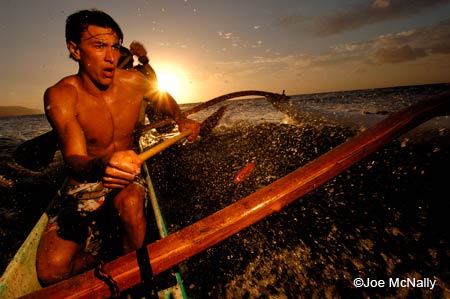 |
| Chris/Larry: You seem to be doing an
amazing amount of shooting, teaching, writing as well as keeping a
detailed running commentary on your blog. How do you keep so connected to
your work? It canít all be fun. |
| Joe: No. Part of the fast pace is
about the nature of photography today. You're making all of this come
together as an enterprise, as a living, not just as a hobby.
I went to school to be a writer. My books and the blog have enabled me
to re-embrace that art form. I really have a good time doing that because
I enjoy writing. If truth be told, I enjoy it almost as much as I do
photography. You sit down and plan to write the story of what just
happened to you in the field, and it's inevitably kind of ridiculous,
humorous, and mildly compelling, because itís the stuff that happens to a
photographer in the field.
We were teaching yesterday (Photoshop World Boston) and we had these four models sitting on this
WWII jeep in front of a Destroyer in the Boston Shipyard, we didn't know
it, but the place was closing. So this guy just walked over while I'm
shooting, I had 75 people around and these models on a jeep, and the guy
just came to the jeep, turned it on and said Iíve got to take the jeep.
There went the prop. The class just convulsed; I turned around and said
this is what happens on location. Everybody can send you down the tubes on
location, from your subject to the freight elevator guy. |
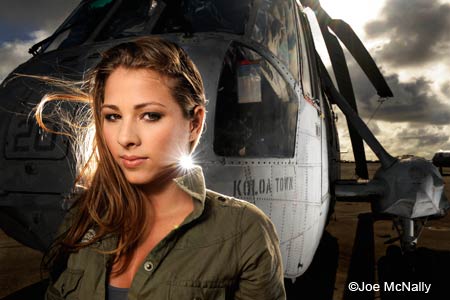 |
| Chris/Larry: So many of the images you
create seem magical, even when you are teaching a workshop. Can you tell
us about your though process, give our readers a sense of how you connect,
overcome problems, and deliver such excellent work? |
| Joe: Let's first get something on the
table; it's not all magical work. Sometimes you have your ups and downs.
It's like playing a sport; you have your good days and bad days. But I do
think the core of what keeps me going forward is basic love and enthusiasm
for being a photographer.
I enjoy the coupling of shooting for clients and teaching. I shoot when
I teach and people in a class expect you to produce something that's
really worthwhile as you demonstrate. Iím shooting live so it's up on the
screen in front of 300 to 400 people. That's what I do all the time. Other
photographers have come up to me and said, "Man, I can't believe you do
that. I would never let them videotape me live. I would have it rehearsed;
I'd have it in the can." I just accept that kind of pressure, itís part
and parcel of being an assignment photographer. I always caution people
that we're going to make a series of mistakes and find our path through
our mistakes; I'm very unabashed about that. I make mistakes all the time
and that is a very valid way to approach any location scenario.
Your digital contact sheet shows your thought process, from the first
frame where you're just doing location assessment and following that
through, it's your thought process right there. When I came up
photographically, really good photo editors couldn't care less about your
portfolio, you know, your greatest hits. They were like yeah, sure kid,
yeah that's nice, but let me see your contact sheets.
Your contact sheets are the roadmap for what you're thinking when you
have a camera in your hand. If you go through a digital take when you are
building a solution, lighting or whatever, you go back through that and
youíll see the photograph build. You see frames where you misfired, frames
where things were off, and then finally, usually through this process, you
establish what I refer to as clarity of thought.
I teach a lot of lighting; people are messing with the lighting, but I
say look, before you start messing with the lighting, you got to mess with
the picture. Where the camera goes is much more important than where the
light goes. Once you figure out where the camera goes, then putting the
light in an effective place is much easier. |
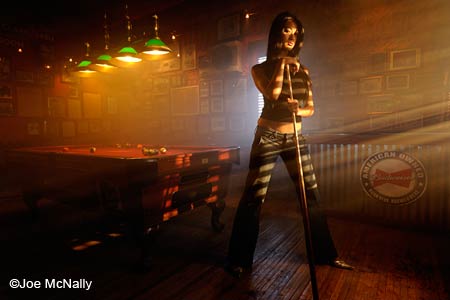 |
| Chris/Larry: When Nikon introduced the
Creative Lighting System in 2003, they asked you to create the DVD Speed
of Light, which really showed what the system could do. Did it take you
long to grasp and master CLS? |
| Joe: Yes and no. Not to come down the
middle there, but no in the sense that once you crank through the buttons
and dials the first few times, it becomes pretty intuitive. Physically
working the flashes is not too much of an issue. Wrangling good light from
small spectral light sources like these becomes the larger issue for me.
How to craft that in the same way as if you were shooting bigger studio
lights. The CLS, as Nikon brought it out, is a truly a wonderful flash
system because it works.
Does it have glitches, ups and downs, misfires, and stuff like that? Of
course, every camera and every system does, and I think that that's where
some folks get a little frustrated. I always remind people that it's a TTL
system, Through The Lens, so when you point the lens at something, all
that exposure information is streaming into the camera. You shift your
angle, change your lens, you're going to get a different stream of photo
information or exposure information, which is going to send a different
message to your flash.
Therefore, the flash will react in a way that it thinks is appropriate
but it might be way off and you say hey, wait a minute, it was fine a
minute ago. Then you start to identify situations where TTL is going to
not work so well, and other situations you walk in and see immediately
that this is tailor-made for TTL.
The nice thing about the lights is that by working with the information
that's occurring at the moment of exposure, you've got a tremendous amount
of intuitive technology to use, which is pretty great. I always regard it
as a gift. Young photographers sometimes get frustrated with it and I'm
like hey, wait a minute dude, you know, not too long ago we were out there
with a couple of rocks trying to make sparks. This is very sophisticated
stuff that we're doing now, so just roll with it. |
| Chris/Larry: You convinced National
Geographic to let you shoot The Future of Flying story entirely digitally
back in the two megapixel era of 2002. Can you tell us a little bit about
how you convince your clients when you want to take them to the next
level, a place that maybe they don't even understand? |
| Joe: I think part of our mission is to
educate our clients, to make them aware of possibilities, to talk them
back off the cliff of where they have always been standing, and say look,
you don't have to jump that way this time, you can maybe do something
different. I've been really blessed to work with some really great art
directors. A couple of commercial clients I have an ongoing relationship
with and they really are open to that because the best relationship is
that the client picks the photographer because they feel this photographer
can bring something to the party they really are interested in. |
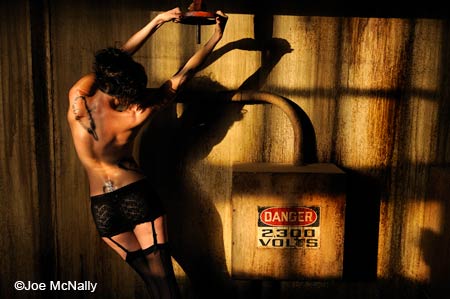 |
| Chris/Larry: What about your workflow?
Can you tell us a little bit about the technical side and how you review
and post-process your final images? |
| Joe: My camera system is Nikon and I'm
shooting D3's. I shoot Lexar cards. All the imagery is organized in
Aperture libraries and we use Aperture as a management program: sorting,
pulling, slideshows, and this and that. I do raw finishing in Nikon
Capture NX 2 and then the final shaping and presentation of the imagery in
Photoshop CS4. My assistant and I have MacBook Proís and we have three
Macs in the studio with the Cinema Displays and a Wacom Cintique. Let me
also issue this disclaimer, I don't do much retouching. I'm not good at
it; I've tried off and on to learn about it, but I've been staying kind of
busy, so it's a little hard and a little elusive for me. If there is any
post-processing and finishing to be done, my assistant does it and we
consult with each other. |
| Chris/Larry: Do you have any advice
for photographers who are struggling now to maintain their love of
photography and their professional standing, things that have helped you
deal with these difficult economic times? |
| Joe: Tenacity is definitely part of
the equation, always has been, probably even more so now. There's a lot of
competition out there and there's a lot of re-trenching on the part of
clients. Money that they might have spent in a more freewheeling way,
they're watching much more carefully and they're deciding to go with last
year's pictures or stock images as opposed to generating work. I'm facing
the same thing, absolutely. I have a new story coming out for Geographic
in June. I shot two stories for them last year and I haven't heard from
them so far this year. We'll see where that goes.
When I was a staff photographer at Life Magazine, it was an interesting
and blessed position. I really had kind of a benevolent patron who would
listen to my ideas and fund them if the editors found them worthwhile.
Now, so much of that is back on the photographer's shoulders, finding
funding, going forward, and generating ideas. It's pretty madcap in lots
of ways, the whole idea of trying to make a living as a photographer now
is a high wire act. Tenacity is a huge part of the equation as well as the
ability to maintain good humor and a positive outlook despite the fact
that you're hearing the word "no" a great deal.
You have to be able to keep moving forward and you have to keep
apprised of new technology. To have a market presence as a photographer, a
blog, or certainly a web site, is required. Itís a way of communicating
and letting people know that you're out there.
Also, try your best to remain aggressive, even in lean times. I think
it's important for photographers because if you look through your
portfolio, your best pictures have almost always occurred when you took a
risk. Whether that is creative, emotional, financial, or whatever it might
be, and nowadays the word is to be risk-adverse. You know, shutter your
doors, close down, do nothing, and weather the storm. But I would argue
that no matter what, to the best of your ability, you have to keep
creating work and take chances. You have to keep pushing your own envelope
or you'll wither right along with the economy. |
|
Check out Joe McNally's
blog and
web site |
|
|
|
Contents of the Interview © 2009 Chris Maher and Larry Berman
Images and text are protected under United States and International copyright laws and may not be reproduced, stored,
or manipulated without written permission of the authors.
|
| |
| Chris
Maher
PO Box 5, Lambertville, MI, 48144
734-856-8882
|
Larry
Berman
PO Box 265, Russellton,
PA 15076
412-401-8100
|
|










